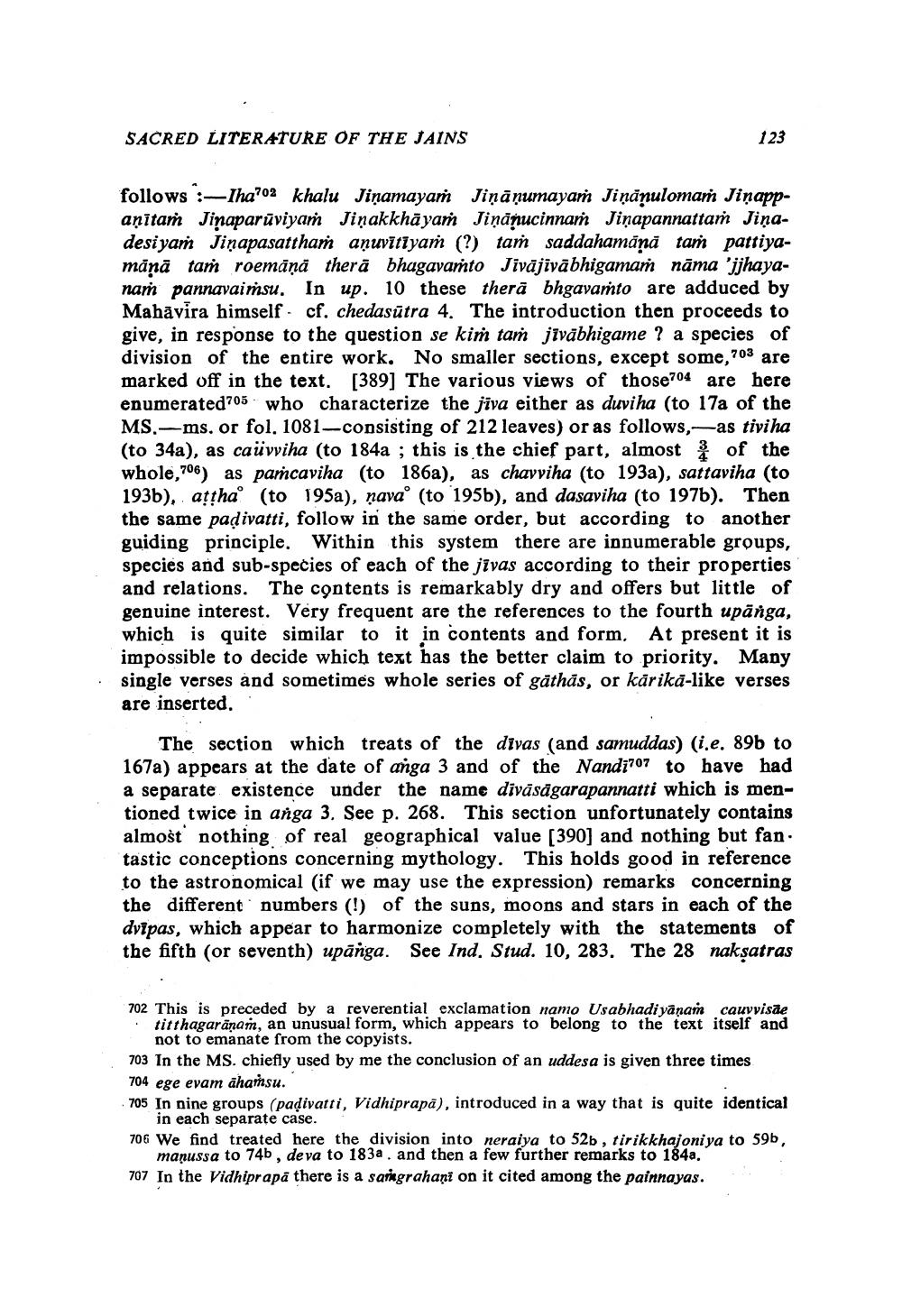________________
SACRED LITERATURE OF THE JAINS
123
follows :- Iha?02 khalu Jiņamayam Jiņāņumayaṁ Jiņānulomaṁ Jiņappaņītaṁ Jinaparūviyam Jiņakkhāyam Jiņānucinnaṁ Jiņapannattaṁ Jiņadesiyam Jiņapasatthaṁ aņuvītīyam (?) taṁ saddahamāna taṁ pattiyamānā taṁ roemāņā therā bhagavaṁto Jivājivābhigamaṁ nāma 'jjhayanaṁ pannavaimsu. In up. 10 these therā bhgavarto are adduced by Mahāvira himself. cf. chedasūtra 4. The introduction then proceeds to give, in response to the question se kim tam jivabhigame ? a species of division of the entire work. No smaller sections, except some, 703 are marked off in the text. [389] The various views of those704 are here enumerated?05 who characterize the jīva either as duviha (to 17a of the MS.-ms. or fol. 1081 --consisting of 212 leaves) or as follows, -as tivi ha (to 34a), as caüvviha (to 184a ; this is the chief part, almost 3 of the whole, 706) as paṁcaviha (to 186a), as chavviha (to 193a), sattaviha (to 193b), atthao (to 195a), navao (to 195b), and dasaviha (to 197b). Then the same padivatti, follow in the same order, but according to another guiding principle. Within this system there are innumerable groups, species and sub-species of each of the jīvas according to their properties and relations. The contents is remarkably dry and offers but little of genuine interest. Very frequent are the references to the fourth upanga, which is quite similar to it in contents and form. At present it is impossible to decide which text has the better claim to priority. Many single verses and sometimes whole series of gäthäs, or karika-like verses are inserted.
The section which treats of the divas (and samuddas) (i.e. 89b to 167a) appears at the date of anga 3 and of the Nandi707 to have had a separate existence under the name divāsāgarapannatti which is mentioned twice in anga 3. See p. 268. This section unfortunately contains almost nothing of real geographical value [390] and nothing but fan. tastic conceptions concerning mythology. This holds good in reference to the astronomical (if we may use the expression) remarks concerning the different numbers (!) of the suns, moons and stars in each of the dvipas, which appear to harmonize completely with the statements of the fifth (or seventh) upānga. See Ind. Stud. 10, 283. The 28 naksatras
702 This is preceded by a reverential exclamation namo Usabhadi yānañ cauvvisãe . titthagarānam, an unusual form, which appears to belong to the text itself and
not to emanate from the copyists. 703 In the MS. chiefly used by me the conclusion of an uddesa is given three times 704 ege evam āhansu. 705 In nine groups (padivatti, Vidhiprapā), introduced in a way that is quite identical
in each separate case. 706 We find treated here the division into neraiya to 52b , tirikkhajoniya to 596,
maņussa to 74b, deva to 183a. and then a few further remarks to 184a. 707 In the Vidhiprapa there is a saragrahari on it cited among the painnayas.
M




